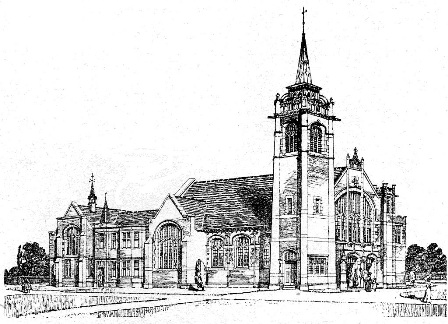A newspaper article from 1910 describing the proposed Primitive Methodist Church, St.Annes.
PROPOSED PRIMITIVE METHODIST CHURCH
A HANDSOME AND IMPOSING
STRUCTURE.
The accompanying sketch is of the proposed Primitive Methodist Church at St.
Annes, the foundation stones of which will be laid on Monday, August 1st. The brief history of the
Primitive. Methodist Church, in St. Annes, is an interesting romance in church building. The Rev.
G. Bicheno was appointed by the Missionary Committee of the Connexion to found a church here, the
first instance of a minister being stationed without a church.
Mr. Bicheno threw himself into his task with energy, and he was well supported
by the Missionary Committee. The old Liberal Club, in Garden Street, was secured, and after being
renovated and furnished, was turned into a Church Hall, where services are held weekly. The pastor
is acting up to his reputation as a church builder, and very soon after the Church Hall was freed
from debt he set about a permanent church. Splendid offers of help were soon forthcoming, headed by
the generous President of the Conference, Sir William Hartley.

The appointment of the Rev. R. W. Callin, as assistant minister left Mr. Bicheno
free to pursue "the quest of the golden stones" as he terms it, and he has preached and visited
many parts of the country on behalf of the St. Armes Church with wonderful results. His aim is that
the church should be opened free from debt, and there is a fair prospect of this aim being
accomplished.
The new church and school are from designs by Messrs. T. E. Davidson and, Son,
of Newcastle, and was chosen in an architectural competition, the estimated cost of the building
being about £5,000. The church will be erected adjoining the Carnegie Library, with handsome
elevations to Clifton Drive South and King's Road. As will be seen from the sketch the design is
handsome and imposing, which is still further improved by the tower at the corner of the two roads.
The school will face King's Road. The church, which is to seat 450 worshippers, will be built with
nave, transepts and chancel, the latter accommodating the choir and organ, and a small, back
gallery over the entrance to seat about 60 people. The buildings are to be of red brick, with stone
dressings, the roof to he covered with Welsh slates. The internal fittings are to be of pitch pine,
and the pulpit of oak. The church windows will be in leaded squares and of tinted Cathedral glass
Heating will be by hot water pipes, and the principal class-rooms will also have open fire
places.
The foundation stone-laying will mark a great occasion, the President having promised to lay the
stone.
|